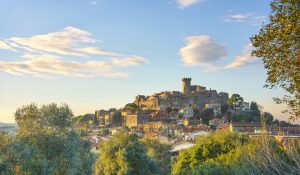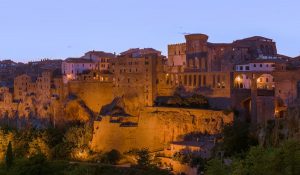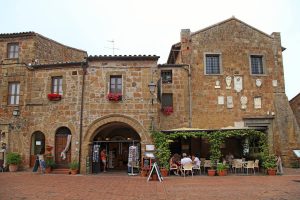
©Bigstock.com/stevanzz
The largest province in Tuscany also has the second fewest inhabitants in the entire region. With its vast, unspoilt areas and nature parks, small chains of hills and numerous islands, including Elba, the Province of Grosseto offers plenty of space and seemingly endless beaches. However, the beauty of the numerous small places around the eponymous capital is often overlooked. Seven of them are part of the private association “I borghi più belli d’Italia”, dedicated to the most beautiful places in Italy. They showcase the exciting history of Tuscany and the province as well as the diverse, almost magically scenery.
Capalbio
The first stop is in the far south of the province. Capalbio (approx. 4,000 inhabitants) was originally a gift from Charlemagne to the Roman monastery Tre Fontane in 805 and saw changing rulers (such as the Aldobrandeschi) in later centuries, who left their mark on the place that managed to retain tis medieval feel. Numerous politicians, intellectuals and celebrities chose Capalbio as a retreat for its beauty and tranquillity, which will hardly surprise you when you visit the borgo. The medieval town plan remains intact, surrounded by a thick ring of walls and numerous agricultural areas, some of which belong to the surrounding nature parks. You enter the old centre with its towers, churches and palaces via the imposing Porta Senesa main gate. The magnificent Chiesa di San Nicola with its frescoes is a must-see, as is the extensively decorated Oratorio della Provvidenza on the outskirts of the town.
Giglio Castello
We cross over to the small island of Giglio, around 50 kilometres south of Elba and 18 kilometres west of the Monte Argentario peninsula in the south-west of the Province of Grosseto. A medieval wall surrounds the main town of Giglio Castello (approx. 650 inhabitants), probably founded in the 10th century. The Aldobrandeschi, one of the oldest noble families in the country, left their mark here. This is evident just from the name of the old fortress alone. Although it was built in the 12th century under Pisan supervision, it is still predominantly called ‘Rocca Aldobrandesca’ today. The 14th century Chiesa di San Pietro Apostolo, extensively renovated in later years and currently looking like an 18th century complex, awaits you in the centre of the town. You can also discover the cellar ruins of an old Roman villa in Giglio Castello.
Montemerano
Speaking of Aldobrandeschi: Montemerano (approx. 500 inhabitants), part of the municipality of Manciano in the Maremma, was once part of the aristocratic family’s sphere of influence and hotly contested for a long time. Three rings of walls, still largely intact today, protect the town. Outside the fortifications, the enchanting 15th century Chiesa della Madonna del Cavalluzzo awaits you. In the town centre, you can stroll through narrow alleyways and across several small squares where you can almost feel the medieval flair, skilfully complemented by various Renaissance houses. However, the undisputed highlight is the Chiesa di San Giorgio with several frescoes and paintings. One of the curiosities is the Madonna della Gattaiola. At one time, this work of art was used as a gateway to a granary and was fitted with a sort of cat door sawn into the centre of the painting.

©Bigstock.com/Nik_Sorokin
Pitigliano
Nestled picturesquely between two deep valleys, Pitigliano (approx. 3,600 inhabitants) was built on a tufa rock and probably dates back to Etruscan settlers. You can discover numerous reminders of this ancient culture around the place, including several publicly accessible burial sites, such as the Tomba Ildebranda, which was wrongly attributed to Ildebrando of Sovana, as well as the remains of the Poggio Buco settlement, which is best explored together with the associated museum. Pitigliano was a place of refuge for expelled and persecuted Jews in the 16th century. The old synagogue and the Jewish quarter in the old town have recently been extensively renovated and opened to the public. Palazzo Orsini, once the only point of access through the defence system, is now home to the bishop’s residence and two museums. A stone relief on the façade of the Chiesa di San Rocco dates back to the 12th century, while the tower of the Cattedrale dei Santi Pietro e Paolo still, well, towers over the town today.
Porto Ercole
Porto Ercole (approx. 2,800 inhabitants) is the smaller of the two towns on the Monte Argentario peninsula in the south of the province. A magnificent harbour and several beaches welcome you with fantastic views. That alone would be reason enough to call Porto Ercole one of the most beautiful places in Italy, but that’s not all. Several old fortresses dominate the townscape, including – you’ve probably already guessed it – a Rocca Aldobrandesca, which was extended by the Medici in the 16th century and given a lighthouse in the 19th century. The three other fortresses date mainly from the era of Spanish administration in the 16th century. Somewhat hidden behind the narrow streets and alleyways, you will finally discover the enchanting little Chiesa di Sant’Erasmo with its Baroque altar and the tombs of Spanish governors. The famous painter Caravaggio, who was found dead in the once malaria-infested swamps in 1610, is also buried here.
Santa Fiora
The year 1274 was of great significance for the Aldobrandeschi family. They split into two branches, one of which chose Santa Fiora (population approx. 2,600) as its homebase. This beautiful village in the east of the Province of Grosseto, already inhabited in the Neolithic period, is surrounded by numerous chestnut trees and divided into three neighbourhoods, the so-called “Terzieri.” The Terziere di Castello is the oldest part of Santa Fiora, where the Aldobrandeschi once resided. The remains of old fortified buildings stand tall around a medieval square. The town hall, however, is located in the Sforza family’s Palazzo Cesarini. You can even recognise the Aldobrandeschi coat of arms on the Pieve delle Sante Flora e Lucilla. Santa Fiora is also known for its abundance of churches, including the Chiesa di Sant’Agostino in the Terziere Borgo. Various wooden figures, canvas and altarpieces and gold-bronze reliquary brushes await you.

©Bigstock.com/felker
Sovana
Do you remember the Tomba Ildebranda from the Pitigliano area? Like many other ancient archaeological sites, it is located in Sovana (approx. 400 inhabitants), part of the municipality of Sorano in the south of the Province of Grosseto. There is, for example, the Hand of Orlando at the junction towards Pitigliano, a hand-like boulder, or the Cavone hollow path criss-crossed with Etruscan traces, as well as numerous other necropolises that will take you back to days long past. This also applies to the town itself, of course with the almost obligatory Rocca Aldobrandesca in the town centre. Piazza del Pretorio is the hub of the medieval centre. Among other things, the 12th century Palazzo Pretorio with a façade decorated with numerous coats of arms and the Chiesa di Santa Maria with an 8th century pre-Romanesque ciborium – the only one in the whole of Tuscany – can be found here.
While one family has left its mark on many of the most beautiful places in the Province of Grosseto, there are many more beauties to discover in the south of Tuscany. The charming medieval flair, the sheer endless meadows and fields, plus inviting beaches and great views – and then there are those cosy strolls through sleepy little villages where the spirit of days long gone is skilfully made tangible. The Province of Grosseto is without doubt an insider tip, a hidden gem and at the same time the ideal opportunity to discover and explore one of the country’s most popular tourist regions in a completely different way.